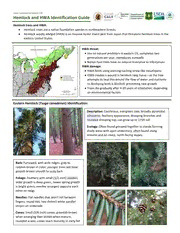
5c4f76eb67cee Pdf PDF
Preview 5c4f76eb67cee Pdf
www.nyshemlockinitiative.info Hemlock and HWA Identification Guide Hemlock trees and HWA: Hemlock trees are a native foundation species in northeastern forests. Hemlock woolly adelgid (HWA) is an invasive forest insect pest from Japan that threatens hemlock trees in the eastern United States. HWA threat: Has no natural predators in eastern US, completes two generations per year, reproduces asexually Native host trees have no natural resistance to infestations HWA damage: HWA feeds using piercing-sucking straw-like mouthparts HWA creates a wound in hemlock twig tissue—as the tree attempts to heal this wound the flow of water and nutrients to devloping buds is blocked, preventing new growth Trees die gradually after 4-20 years of infestation, depending on environmental factors Eastern Hemlock (Tsuga canadensis) Identification: Description: Coniferous, evergreen tree; broadly pyramidal silhouette; feathery appearance; drooping branches and rounded drooping top; can grow up to 175ft tall Ecology: Often found grouped together in stands forming shady areas with open understory; often found along streams and on steep, north-facing slopes. Bark: Furrowed, with wide ridges; grey to reddish-brown in color; younger trees will have greyish-brown smooth to scaly bark Foliage: Feathery with small (1/2-inch) needles; older growth is deep green, newer spring growth is bright green; needles arranged opposite each other on twigs Needles: Flat needles that won’t roll between fingers; round tips; two distinct white parallel stripes on underside Cones: Small (3/4-inch) cones; greenish-brown when emerging then brown when mature; rounded scales; cones reach maturity in early fall Hemlock and HWA Hunters ID Guide continued Hemlock Woolly Adelgid (HWA, Adelges tsugae) Identification: May-October Late Spring-Early Fall: HWA is not growing, they are in a dormancy period known as aestivation. This time of year HWA appears as small, black nymphs, called sistens, at the base of hemlock needles on tree’s new growth. The sesame seed-shaped sistens will have a distinct white halo. Finding HWA at this time of year may require use of a magnifying glass or hand lens (7x or 10x magnification). Tips: It may help to look at underside of twigs for HWA; remnants of wool from previous season may also be present. HWA Identification: November-April Late Fall-Early Spring: HWA goes through four development stages or “instars” as it secretes its “wool” then lays its eggs as an adult. During this time an infestation will be characterized by white, waxy masses that are secreted around the bodies of the insect, always clumped on twigs near the base of the hemlock needles. Tips: Sometimes the infestation is best seen while looking at the underside of a hemlock twig. In the case of a lighter infestation you may only see one or two woolly masses present. Other Clues of a Potential HWA Infestation (not certain, additonal surveying needed if found): Hemlock Borer: The reddish- Weakened tree crown: A heavy or Greyish cast: HWA infestations can purple inner bark of hemlocks is long-lived HWA infestation will cause hemlock trees to appear greyish exposed by woodpeckers as they cause crown damage and rather than a healthy deep green. feed on hemlock borer, a native defoliation. Look up to check if the Hemlock trees with a greyish beetle that feeds on the juicy crown appears full and dense or appearance can easily be seen from a inner bark. The beetle attacks thinning. Lots of dead branches distance, like those located along only weakened trees, often after and lack of needles could indicate shorelines. Boaters may be able to spot prolonged exposure to HWA. an HWA infestation. HWA infested trees from the water.
